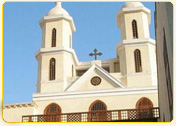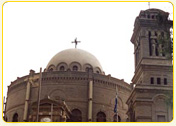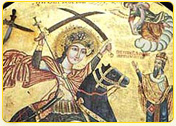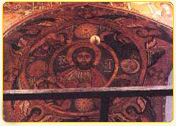Cairo - The Hanging Church (Al-Mu'allaqa)
Originating in the 4th century, the Hanging Church was built over the southern Gate of the Fortress of Babylon. Dedicated to the Virgin Mary, its treasures include a 14th-century wall-painting of the Nativity.

Cairo - The Convent of St.George(Mari Girgis)
In the oldest part of Cairo, the chapel is reached through a Fatimid hallway and contains the relics of St.George in a cedar wood casket.

Cairo - Church of St. Mercurius (Abu Sefein)
Aunique collection of Coptic art including 175 icons representing scenes from the Old and New Testaments, wall paintings and stained glass.

Cairo - Church of St. Sergius and St.Bacchus
A 5th-century basilica, built over a crypt where the Holy Family are believed to have stayed during their flight into Egypt.

The Coptic Museum
The Coptic Museum in Cairo is a life-like record of one of Egypt’s periods all fraught with various antiques and monuments reflecting the different civilizations that graced the land of Egypt starting by the Ancient Egyptian civilization, passing by the Greek, the Roman, the Coptic, and lastly the Islamic.
The Coptic Museum lies behind the walls of the famous Roman Fortress of Babylon in the ancient district of Cairo (Misr Al-Qadima).
The area surrounding the museum abounds in lively monuments of open museums that depict with the Coptic Museum the history of the Coptic Period in Egypt.
Six paramount, ancient, Coptic Churches share ground with the Coptic Museum. They date back somewhere between 5th and 8th century AD. The place holds the church of Abu Serga, the most ancient in Egypt. It was raised above the cave which the Holy Family sought refuge into as they fled from Herodus’s oppression to Egypt.
The place, moreover, embraces Virgin Mary’s Church known as the Hanging Church; a great ancient worship house of world stature that was among the very first to host Coptic rituals on the face of earth. The museum was built in an artchitectural style using wood in ceilings and oriels (arabesque and lattice glass). Some biblical verses are written against them ornamented with Coptic embellishments like plants, especially grapevines, birds such as eagles, ostriches and peacock which all imply a certain philosophy and a specific significance in the Christian creed. Marble pillars and fountains ornamented with mosaic are more than present under the roof.
The Coptic Museum in Cairo encloses rare treasures from the Coptic Period exhibiting a dimension of Egypt’s civilization. The museum consists of two wings divided into several halls. The old wing was inaugurated in 1910 and comprises 13 sections, while the new was opened to the public on February 20, 1947 encompassing 17 halls. The State undertook continuous restorations of the historical building being re-inaugurated on March 8, 1984 by President Mubarak.

